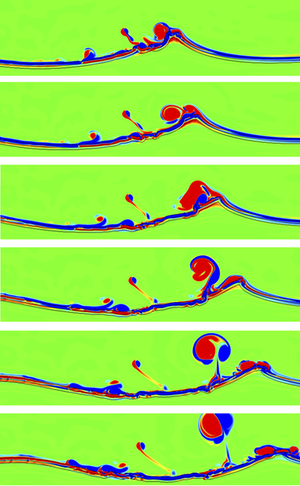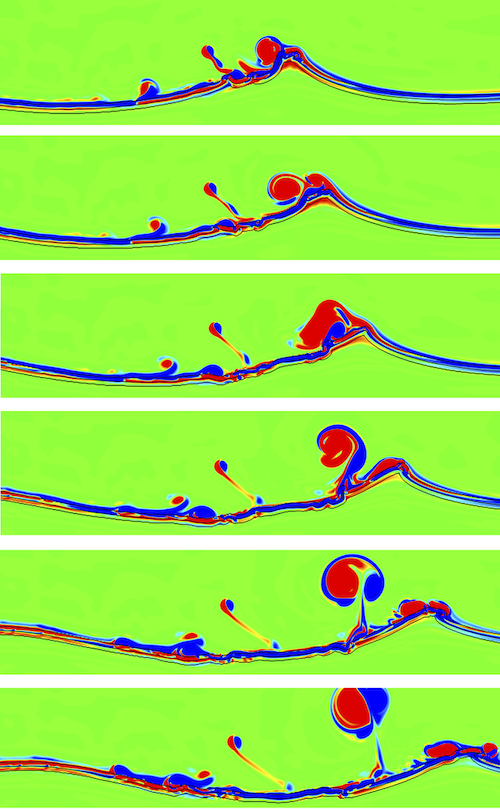Ocean Wave Breaking Stirs Up Atmosphere
Ocean waves breaking far from land often stir up significant motion in the atmosphere, according to simulations published in Physical Review Letters. This finding, based on the most accurate and computationally intensive model to date, contradicts the previous belief among experts, that most of the energy from breaking waves remains in the water. The results could help researchers improve wave forecasting models, which are a component of weather and climate modeling.
In the absence of storms, waves on the open ocean arise from wind blowing over the water. Through a process known as modulation instability, one of the waves in a group can begin stealing energy from its neighbors, eventually growing so steep that it breaks. This process may be responsible for a large fraction of all wave breaking, so researchers want an accurate picture of it, to understand the energy flow between the atmosphere and the ocean. But previous attempts to simulate such wave breaking have relied on relatively simple models that ignored potentially important effects, like the viscosity of water and interactions between water and air. One consequence of this lack of air-water interaction was that any energy released by wave breaking remained entirely in the water.
Miguel Onorato of the University of Turin in Italy and his colleagues addressed these deficiencies by applying the most complete fluid dynamical model, the Navier-Stokes equation, to the water and the air simultaneously. The simulation took three to four weeks instead of a minute and a half, as would have been possible with simpler models, says Onorato. To keep the simulations manageable, the team assumed that the only changes occurred in the direction of wave travel—like a wave on string, rather than a D surface wave.
To their surprise, the researchers found that about three-quarters of the breaking wave’s energy ended up in the air. Much of this energy went into vortices, or pockets of rotating air, above the ocean surface. These vortices formed counter-rotating pairs known as vortex dipoles that were then launched to heights of up to meters. Such vortices could transport tiny water droplets known as aerosols into the atmosphere, where they could seed clouds. Onorato finds this possibility “the most intriguing part” of his team’s results, because it could change weather forecasters’ understanding of cloud formation. And since clouds absorb incoming sunlight as well as thermal radiation from the Earth, the results may also affect climate modeling.
Onorato notes that his team’s model did not explicitly include aerosols and that current climate models are too coarse to resolve the effects his model predicts. Nevertheless, he thinks the results suggest directions for future work.
The team’s results are “impressive” and improve physicists’ understanding of energy dissipation in breaking waves, says Amin Chabchoub of Imperial College London. “Up ‘till now, we were thinking differently” about where the energy ends up. “It will be really interesting to conduct experiments in order to confirm these results,” in wave tanks or other experimental settings, says Chabchoub. Onorato says he has already begun such experiments.
–Gabriel Popkin
Gabriel Popkin is a freelance science writer in Washington, DC.





